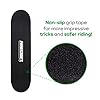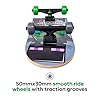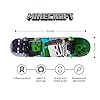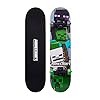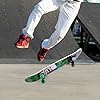Wemfg Kids Protective Gear Set Knee Pads for Kids 3-14 Years Toddler Knee and Elbow Pads with Wrist Guards 3 in 1 for Skating Cycling Bike Rollerblading Scooter
9% OffHoverboards have captured imaginations since their debut, blending fun, tech, and eco-friendly transport. Often called self-balancing scooters, these devices aren’t true “hovering” boards yet—but innovations are pushing boundaries. In this guide, we’ll explore the invention history, key components, buying tips, and 2025 updates. Whether you’re a kid, adult, or tech enthusiast in the USA, we’ve got facts backed by reliable sources to help you decide.
As of September 2025, the hoverboard market is booming, with global sales projected to hit $1.6 billion by 2034 due to safer designs and smart features. New models emphasize UL 2272 certification to prevent fires, and flying variants are evolving rapidly.
What Is a Hoverboard? 🔍
A hoverboard is a self-balancing, two-wheeled electric scooter that uses gyroscopes and sensors to detect your lean and move accordingly. Despite the name (inspired by sci-fi like Back to the Future), most models roll on wheels rather than truly hover. They’re popular for short commutes, fun rides, and even off-road adventures.
- Key Benefits: Eco-friendly (zero emissions), portable, and speeds up to 10-15 mph.
- Drawbacks: Limited range (5-12 miles per charge) and terrain restrictions on basic models.
In 2025, advanced hoverboards integrate apps for speed control and GPS tracking, making them smarter than ever.
Who Invented the Hoverboard? 🧑🔬
The modern hoverboard, or self-balancing scooter, was invented by Shane Chen, a Chinese-American entrepreneur. He filed the patent for the “Hovertrax” in 2012, which was granted in 2014. Chen, based in Camas, Washington, founded Inventist and drew from his experience with inventions like the Solowheel (a self-balancing unicycle from 2010).
- Born in Beijing, Chen immigrated to the US in 1986 for better opportunities.
- His Hovertrax debuted in 2013, but knockoffs from China flooded the market, costing him millions despite the patent.
- Fun Fact: Chen has over 20 patents, including orbit wheel skates and a two-wheeled car prototype in 2023.
Early safety issues (like battery fires) led to recalls, but 2025 models are safer with mandatory UL certifications. Chen continues innovating, focusing on personal mobility.
What Is Inside a Hoverboard? ⚙️
Hoverboards pack smart tech into a compact frame. A standard model includes:
- Batteries: Two lithium-ion packs (one per wheel) for power storage and up to 12 miles of range. Quick-charge options take 1-2 hours.
- Gyroscopes and Sensors: Two gyroscopes (one per wheel) detect tilts for balance. Accelerometers help maintain stability.
- Motors: Dual electric motors (200-500W each) drive the wheels independently for smooth turns.
- Motherboard: Controls speed, balance, and safety features like auto-shutoff.
- Advanced Add-Ons: Bluetooth speakers, LED lights, and app connectivity in premium models.
For durability, look for rugged frames and IP54 water resistance. In 2025, many include AI for better obstacle detection.
| Component | Function | Typical Specs |
|---|---|---|
| Batteries | Power source | 36V, 4.4Ah lithium-ion |
| Gyroscopes | Balance detection | Dual-axis sensors |
| Motors | Propulsion | 350W per wheel |
| Wheels | Mobility | 6.5-10 inches, rubber or all-terrain |
Who Invented the Flying Hoverboard? 🚀
True hovering boards (without wheels) come in two main types:
- Magnetic Levitation (Maglev): Invented by Greg Henderson and his wife Jill Henderson in 2013 via Arx Pax. Their Hendo Hoverboard uses magnetic fields to repel over conductive surfaces like copper. It’s limited to special tracks but inspired real hover tech.
- Jet-Powered: Franky Zapata created the Flyboard Air in 2016, a turbine-powered board that flies up to 10,000 feet. In 2019, he crossed the English Channel in 22 minutes at 100+ mph. Zapata’s design is for pros, not everyday use.
Latest in 2025: The ArcaBoard 2 from ARCA Space is a fan-powered flying board that hovers 1-2 feet off any surface, priced at $15,000+. It’s electric, quiet, and available for pre-order— a step toward consumer flying boards. 😎
Who Invented the Hoverboard Segway? 🛴
The Segway, a precursor to modern hoverboards, was invented by Dean Kamen in 2001. This two-wheeled personal transporter uses gyroscopes for balance and was hailed as revolutionary. Segway Inc. produced it, but it faced legal hurdles for sidewalk use.
- Not a true hoverboard, but it influenced designs like Chen’s.
- In 2025, Segway-Ninebot offers hybrid models with hoverboard tech, like the Ninebot S at 10 mph.
Should You Buy a Hoverboard? 💡
Yes, if you want fun, short-distance transport! Consider your needs:
- For Adventure: Off-road models with 8-10″ wheels.
- For Commuting: Lightweight, 10+ mile range.
- For Kids: Slower speeds (6-8 mph) and parental controls.
Budget: $150-500. If affordable, go for it—alternatives like bikes or e-scooters might be cheaper long-term, but hoverboards are more thrilling.
2025 Tip: Prioritize UL 2272-certified models to avoid recalls. Market growth means better deals on Amazon.
Editor’s Pick: Best Hoverboard for 2025
TOMOLOO Hoverboard with Bluetooth Speaker and LED Lights
UL2272 certified, 6.5″ wheels, 7.5 mph max speed, 12-mile range. Great for kids 6-12 and adults. Bluetooth for music, colorful LEDs for night rides. ⭐⭐⭐⭐⭐ (4.5/5 from 5,000+ reviews)
Price: ~$150 (check for deals)
(Stock: Available as of Sept 2025; if out, try similar Gyroor G2 for all-terrain.)
Tips to Buy the Best Hoverboard in 2025 📝
- UL Certification: Essential for safety—avoids fire risks.
- Wheel Size: 6.5″ for smooth surfaces; 8-10″ for rough terrain.
- Material & Build: Aluminum alloy for durability; avoid cheap plastics.
- Battery & Charging: 1-2 hour charge time; 36V for longer range.
- Weight Capacity: 220-300 lbs max.
- Speed & Range: 6-15 mph; 8-12 miles.
- Extras: Bluetooth, LEDs, speakers for fun. 🌟
- Warranty: 1-year minimum.
Top 2025 Picks: Gyroor G2 (best overall), Hover-1 Chrome 2.0 (budget), Segway Ninebot S (premium). Shop on Amazon for fast USA shipping.
Latest Updates on Hoverboards in 2025 🔄
- Market Growth: Expected to reach $957 million globally, driven by kids’ models and smart integrations.
- Safety Focus: All major brands require UL 2272; no major recalls since 2020.
- Innovations: App-controlled speeds, voice commands, and hybrid e-scooter designs.
- Flying Advances: ArcaBoard 2 flies for real—pre-orders open at $14,900.
- Eco-Trends: Solar-charging batteries in prototypes for greener rides.
From X (formerly Twitter), users buzz about attachments like TRIGOSCOOT for cargo hauling.
Conclusion 🎉
Shane Chen gifted the world the hoverboard in 2012, sparking a revolution in personal transport. With flying versions from inventors like Franky Zapata and Greg Henderson, the future looks airborne. For USA buyers, grab a safe, certified model like the TOMOLOO—perfect for fun and function. Ready to ride? Check Amazon today! 🚀
Related Reads:

I’m the founder of HoverboardsGuide.com, a comprehensive website dedicated to electric scooters and hoverboards. With a deep-rooted passion for electric gadgets, I’ve accumulated extensive experience in this field. I aim to assist users in selecting the best gadgets and providing reliable guidance.
I’ve tested and reviewed numerous models, gaining in-depth knowledge about their features, performance, and overall quality. Feel free to reach out to me with any queries, as I’m dedicated to addressing your concerns promptly. Join me on this exciting journey of exploring the world of electric rides and making informed decisions









